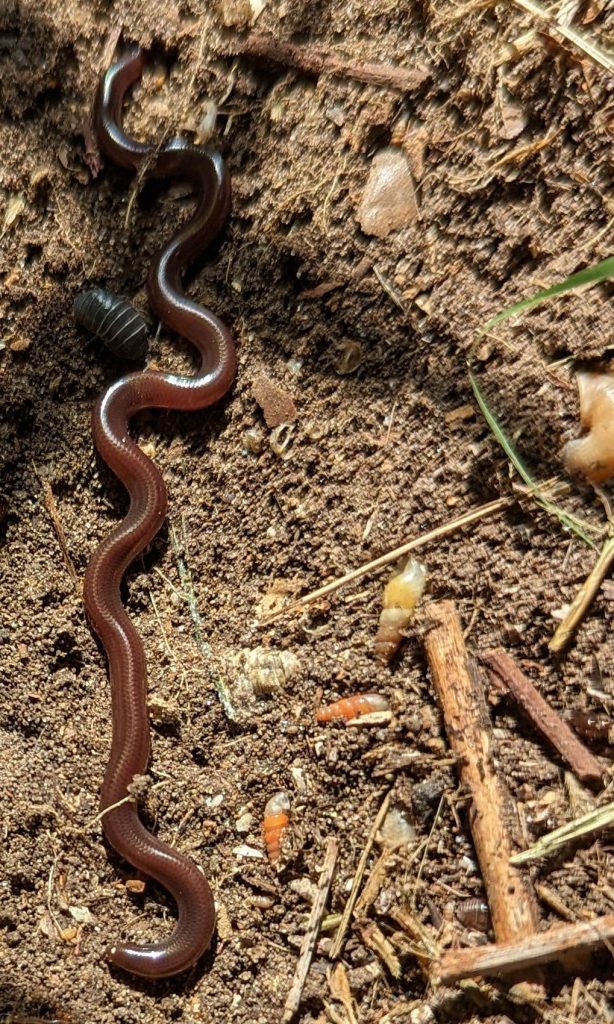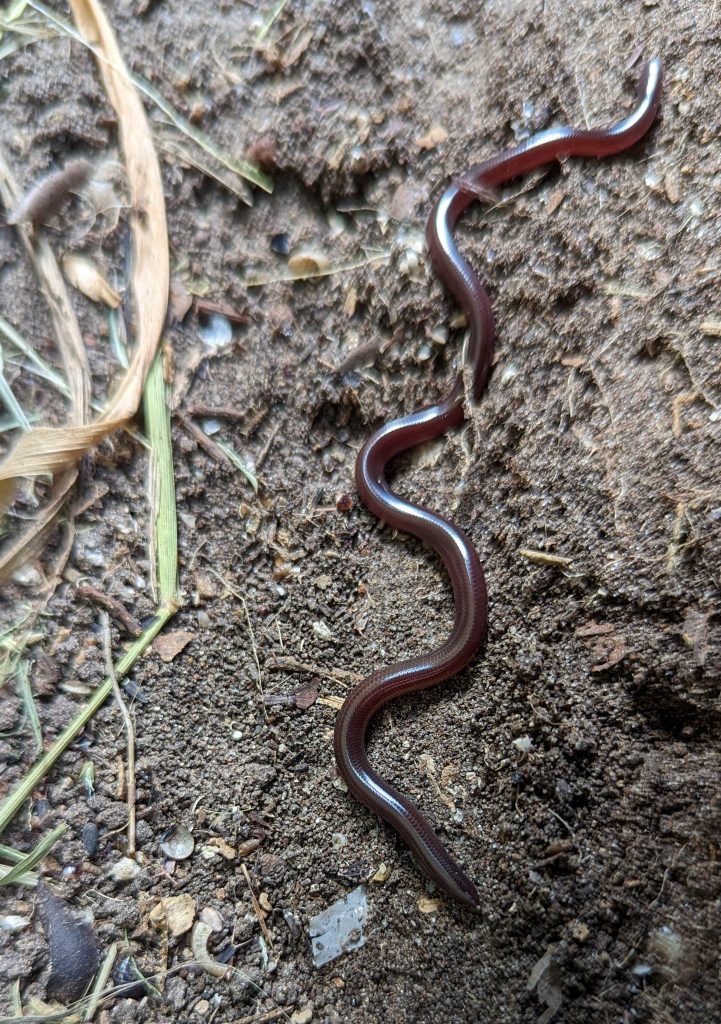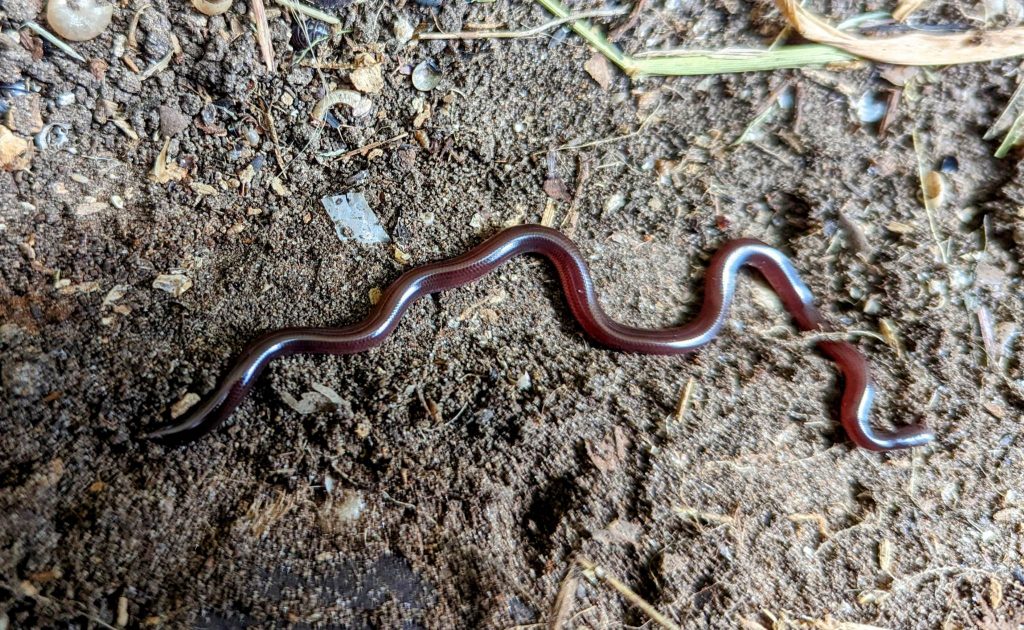We lifted a small log, one with critter-enticing voids and cracks, exposing an expected assortment of busy creatures—beetles, ants, silverfish and roly-poly’s. But, amid them, to my surprise, squirmed a dark, glossy worm. What is an earthworm doing in a Harlingen yard in this arid climate? I thought. I rarely see worms here.

Soon, though, it dawned on me that this smooth, unsegmented creature was no worm, but a blind snake. Fond of such, my granddaughter and I exulted. Peering under this log on spring days, we often uncovered this serpent, or its cousin, wriggling, until, understandably perturbed, it sidewinded beneath the fence or eased its way beneath a blanket of dirt.
Now that we’ve settled into summer heat and drought, this fossorial, or burrowing, snake has opted to remain underground, tunneling through leaf litter and soil in its quest for wee creatures—especially ants and termites, their larvae and pupae. Its skinny head, blunt nose, firm skull and smooth body facilitate this operation, along with a top jaw that moves independently, allowing it to easily scoop up items.
The Lower Rio Grande Valley hosts two similar-looking blind snakes: the native Texas threadsnake (Rena dulcis) and the one I observed—which the ever-helpful iNaturalist app helped me identify—the nonnative Brahminy blind snake. Originally a South Asian species, it is often dubbed “flowerpot snake” for its apparent mode of travel. Now inhabiting all continents except Antarctica, it first appeared in Guerrero, Mexico in 1891, Hawaii—apparently in potted palm trees—in 1927, Florida in 1979 and Texas in 1998. Since it’s tolerant of human activities, we more often spot the Brahminy than the threadsnake in our backyards. In fact, one may find the Brahminy wriggling in a bathroom or other indoor area as it seeks moisture and prey. After spring rains one year, we were shocked to see one slithering along our living room tile.
The small, cosmopolitan Brahminy—content in varied terrains in both temperate and tropical climates— causes no noticeable harm in its wanderings, though Bahamans have expressed some concern that it might compete for resources with their four native blind snakes.

Also called “bootlace snake” for its shape and size, the Brahminy blind snake (Indotyphlops braminus) has a silvery gray or purplish sheen and a blunt, similar-looking head and tail. Tiny eyes, which perceive scant light, resemble dark patches beneath scales. Its tail ends with a pointy spur-like scale, with which it may anchor itself or gently poke an intruder. Its scales are small, and it lacks a rostral, or mouth-bordering one.
All Brahminy blind snakes are female. Being pathenogenetic, they reproduce asexually. (“Parthenos” means “virgin”). The mother lays from one to eight eggs.
While most snakes devour prey headfirst and whole, the Brahminy blind snake demonstrates an interesting tendency to decapitate termites before eating them. A study done with 7 snakes and 100 termites revealed that the snakes did this—swallowing termites back-first, rubbing their heads against a surface to break them off— 47% of the time, and sometimes, after consuming an entire termite, a snake regurgitated it and removed the head before downing it again. Fecal matter showed only undigested heads. Some presume that by decapitating them, snakes are avoiding toxic substances in termite heads. However, head-swallowing snakes did not sicken. More likely, the snakes remove heads for efficiency, to maintain room in their guts for digestible matter.
Besides jabbing a foe with its pointy tail, the snake may release a smelly musk from two glands at its base. This snake can live without food for a while, as witnessed once when, consumed by an Asian toad, it eventually exited its anus, seemingly no worse for wear.
Scientists once thought modern snakes evolved from primitive blind snakes—as David Attenborough alludes to in this fascinating portion on Brahminy snakes in from BBC’s “Life in Cold Blood” from 2008: https://www.youtube.com/watch?v=IjNwcw3ZuyA. Current thinking, though, is that blind snakes branched off from other snake families.
The tiny-mouthed Brahminy blind snake is harmless, and it assists us by eradicating pests. And possibly this snake, like the Texas threadsnake, provides housekeeping services to Eastern screech owls, who sometimes snatch a threadsnake and tote it to their nests, where, if not eaten, the unwitting captive devours harmful mites and larvae, to the benefit of resident owlets. I see no studies indicating the owl also seizes the Brahminy for maid duty, but would an owl discriminate?
